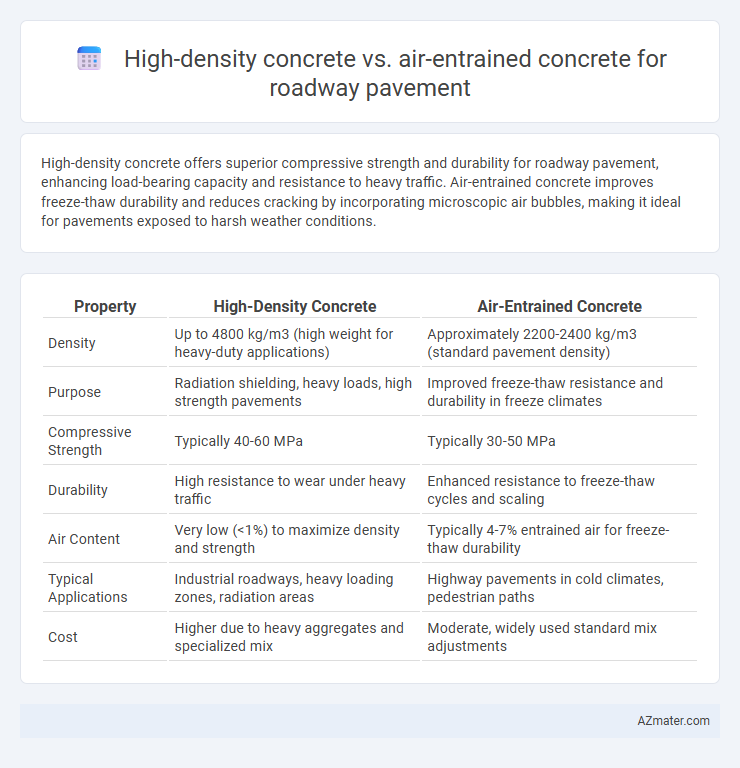High-density concrete offers superior compressive strength and durability for roadway pavement, enhancing load-bearing capacity and resistance to heavy traffic. Air-entrained concrete improves freeze-thaw durability and reduces cracking by incorporating microscopic air bubbles, making it ideal for pavements exposed to harsh weather conditions.
Table of Comparison
| Property | High-Density Concrete | Air-Entrained Concrete |
|---|---|---|
| Density | Up to 4800 kg/m3 (high weight for heavy-duty applications) | Approximately 2200-2400 kg/m3 (standard pavement density) |
| Purpose | Radiation shielding, heavy loads, high strength pavements | Improved freeze-thaw resistance and durability in freeze climates |
| Compressive Strength | Typically 40-60 MPa | Typically 30-50 MPa |
| Durability | High resistance to wear under heavy traffic | Enhanced resistance to freeze-thaw cycles and scaling |
| Air Content | Very low (<1%) to maximize density and strength | Typically 4-7% entrained air for freeze-thaw durability |
| Typical Applications | Industrial roadways, heavy loading zones, radiation areas | Highway pavements in cold climates, pedestrian paths |
| Cost | Higher due to heavy aggregates and specialized mix | Moderate, widely used standard mix adjustments |
Introduction to Concrete Types for Roadway Pavements
High-density concrete used in roadway pavements offers enhanced strength and durability due to its higher specific gravity and inclusion of heavy aggregates, making it ideal for heavy traffic and industrial applications. Air-entrained concrete contains tiny air bubbles that improve freeze-thaw resistance and provide better workability, crucial for pavements exposed to harsh weather conditions. Selecting between high-density and air-entrained concrete depends on the specific pavement performance requirements, such as load-bearing capacity and environmental exposure.
High-Density Concrete: Composition and Key Features
High-density concrete for roadway pavement incorporates heavy aggregates such as barite, magnetite, or hematite, achieving densities typically above 3,800 kg/m3, which enhances load-bearing capacity and durability. This composition improves resistance to abrasion, impact, and radiation, making it ideal for high-traffic and heavy-load applications. The dense matrix also reduces permeability, contributing to longer service life and better performance under harsh environmental conditions compared to standard air-entrained concrete.
Air-Entrained Concrete: Properties and Advantages
Air-entrained concrete contains microscopic air bubbles that enhance its resistance to freeze-thaw cycles and improve durability for roadway pavements. This type of concrete exhibits increased workability, reduced permeability, and better resistance to scaling caused by de-icing salts, making it ideal for harsh climates. Its superior durability and flexibility reduce maintenance costs and extend pavement lifespan under heavy traffic and environmental stress.
Strength and Durability Comparison
High-density concrete offers superior compressive strength, often exceeding 8,000 psi, making it ideal for heavy traffic pavements subject to high static loads, whereas air-entrained concrete typically ranges between 3,000 to 5,000 psi with enhanced freeze-thaw resistance. The entrained air bubbles in air-entrained concrete improve durability by preventing moisture damage in climates with frequent freeze-thaw cycles, reducing scaling and cracking risks. High-density concrete's increased mass also provides excellent radiation shielding and abrasion resistance, but it may be less effective in freeze-thaw environments compared to the optimized freeze-thaw durability of air-entrained mixes designed specifically for roadway pavements.
Performance in Extreme Weather and Freeze-Thaw Cycles
High-density concrete exhibits superior durability and resistance to freeze-thaw cycles in roadway pavement due to its low porosity and high compressive strength, reducing water absorption and minimizing cracking. Air-entrained concrete enhances freeze-thaw performance by incorporating microscopic air bubbles, which provide space for water expansion during freezing, thereby increasing resistance to surface scaling and internal damage. For extreme weather conditions, air-entrained concrete generally outperforms high-density concrete by maintaining flexibility and preventing spalling, making it a preferred choice in areas with frequent freeze-thaw cycles and deicing chemical exposure.
Load-Bearing Capacity Differences
High-density concrete exhibits significantly higher load-bearing capacity compared to air-entrained concrete due to its increased density and reduced porosity, making it ideal for heavy-duty roadway pavement applications. Air-entrained concrete, while improving freeze-thaw resistance, has lower compressive strength and is less suited for areas with extreme traffic loads. Selecting high-density concrete enhances pavement durability and structural integrity under heavy vehicular stresses.
Sustainability and Environmental Impact
High-density concrete, composed of heavy aggregates like barite or magnetite, offers increased durability and load-bearing capacity, reducing maintenance frequency and extending roadway lifespan, which lowers long-term environmental footprint. Air-entrained concrete incorporates microscopic air bubbles that improve freeze-thaw resistance and reduce cracking, enhancing pavement durability in cold climates and minimizing resource use for repairs. Choosing between these concretes impacts sustainability through differences in raw material sourcing, with high-density concrete often requiring energy-intensive aggregate extraction, while air-entrained concrete promotes longevity with less environmental disruption.
Cost Implications and Lifecycle Analysis
High-density concrete offers superior strength and durability for roadway pavement but involves higher initial material and production costs compared to air-entrained concrete. Air-entrained concrete, with its enhanced freeze-thaw resistance, reduces maintenance expenses and extends pavement lifespan in colder climates, leading to lower lifecycle costs. Evaluating total cost of ownership reveals that while high-density concrete demands greater upfront investment, air-entrained concrete often delivers better long-term economic efficiency through reduced repair frequency and improved resilience.
Best Use Cases: When to Choose Each Concrete Type
High-density concrete is best suited for roadway pavements requiring enhanced durability and radiation shielding, such as airport runways and heavy traffic bridges, due to its superior compressive strength and density. Air-entrained concrete excels in environments exposed to freeze-thaw cycles and deicing chemicals, offering improved resistance to scaling and cracking by incorporating microscopic air bubbles that enhance durability. Selecting air-entrained concrete is ideal for cold climates with harsh winters, whereas high-density concrete is preferred for structural applications demanding increased load-bearing capacity and protection.
Conclusion: Selecting the Optimal Concrete for Roadway Pavements
High-density concrete offers superior durability and load-bearing capacity essential for heavy-traffic roadways, while air-entrained concrete provides enhanced freeze-thaw resistance and improved longevity in cold climates. Selecting the optimal concrete depends on environmental conditions and traffic demands, with high-density concrete favored for structural strength and air-entrained concrete preferred for resistance to weather-induced damage. Prioritizing these properties ensures pavement performance, safety, and lifecycle cost-efficiency.

Infographic: High-density concrete vs Air-entrained concrete for Roadway pavement
 azmater.com
azmater.com